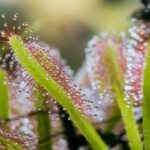As an Amazon Associate, this site earns commissions from qualifying purchases. For more details, click here.
People like sundews because they eat insects, simple as that. There is something about watching a plant eat bugs that fascinates us. And this brings up a good question: can sundew plants eat a mosquito? Because mosquitoes are pests, can we rely on sundews to keep hm at bay?
Sundews eat mosquitoes because they are rich in nutrients like nitrogen and phosphorus which are lacking in the soil. Mosquitoes thrive in bogs and waterlogged locations where sundews dwell, so they are natural prey.
Why Sundews Eat Mosquitoes
Strictly speaking, sundews do not actually ‘eat” mosquitoes, not the way animals consume food. Just like other plants, sundews create their own food.
Sundews use photosynthesis to make food (glucose) which functions as fuel for their daily activities.Carnivorous plants can survive without eating bugs, albeit growth will slow significantly. In contrast, these plants – including sundews- cannot live without light for prolonged periods.
While sundews create food to survive, they also benefit from nutrients. Plants grown in rich soil because of these elements. While sundews also need those elements, they only thrive in poor soil.
Sundews eat mosquitoes and other insects to obtain nitrogen, phosphorus, sulfur and other nutrients. These plants grow in soil that lacks these so they extract these elements from insects.
The difference between food and nutrients is subtle but important. Sundews need food to survive and nutrients to grow. It does not matter if your sundew feeds exclusively on mosquitoes or some Omega 3 5 Pack Bloodworms. What is important is the plant receives those nutrients from somewhere.
So if your home is mosquito free, no worries. Sundews can be fed mealworms or fish food. Sundews eat live and dead bugs alike and both have the same amount of nutrition. The ideal setup for sundews is poor, moist soil, lots of light and high humidity.
Researchers are not sure why sundews only grow in poor soil. But it is evident they have adapted to it. Mosquitoes are prevalent in bogs and waterlogged locations, the natural habitats of sundews. Because mosquitoes are drawn to the dew, carnivorous plants have become their predators.
Growing sundews in rich soil could be fatal. You cannot substitute fertilized soil for insects even though both can provide the same nutrition. The sundew digestive process can only handle nutrients if they come from insects like mosquitoes.
What Happens When Sundews Digest Mosquitoes?
So now we know why sundews consume mosquitoes. The next question is how.
This is how sundews eat all insects, including crickets, ants, fruit flies etc. Its method is simple but effective. How long it took for these traps to evolve is unknown but it serves the plant well.
Because sundews are fixed to their spot, they cannot hunt for prey. Instead carnivorous plants have to lure insects and trap them. Sundews use the flypaper style trap, and you will quickly realize why it is called flypaper.
Sundews have tentacles or stalks, and their tips are covered with dew. Well it is not really dew, it is mucilage, but the name stuck because the substance looks like morning dew.
The dew is made of water and a sticky material. It gives off a powerful scent that draws mosquitoes, flies and other insects. This allows a sundew to lure potential prey right to them.
When a mosquito drops on one of the tentacles to eat the dew, it gets stuck. The tentacle curls up and pulls the trapped insect into the other tentacles to be eaten.
Eventually the mosquito dies from fatigue or gets suffocated. Sometimes the plant will wait for the insect to die before digesting it. In other cases, the digestion begins as soon as the insect has been secured.
The digestive process is similar in a way to that of a Venus flytrap. Enzymes are released which soften up body tissues. This enables a drosera plant to “eat” the insect. Depending on the species, it might take less than a second or days for the sundews to close over a prey.
It takes about 15 minutes for sundews to kill an insect, but consumption may take days. After digestion the plant uses the nutrients for growth, build up resistance to infection and produce more leaves and traps.
The way sundews use nutrients is similar to how people do. This is why it is crucial for sundews – regardless of species- to have sufficient nutrition.
Are Sundews Effective Mosquito Controllers?
Because mosquitoes make up a good part of their diet, why not take advantage of it? Instead of insecticides, why not use these carnivorous plants to keep them away? The question is: how effective are sundews as mosquito killers?
Sundews can only eat 1-4 insects a month, so they are not very effective against a swarm of mosquitoes. At best a sundew plant is ideal for getting rid of the occasional house pest. If there are bugs in your home we suggest using Thermacell Mosquito Repellent.
So if your sundews have already consumed 3 insects this month, it can only eat one more mosquito after that. As pointed out earlier, sundews can take up to a week to consume a prey.
Mosquitoes are rarely a problem indoors unless you keep doors and windows open frequently. If there is a mosquito infestation in your home, find out what is causing it. In these instances, it is better to use an insect repellent rather than a plant to get rid of them.
Sundews can still be useful mosquito repellents in some situations. Maybe you want to spend more time in your garden but cannot do so due to mosquitoes. Putting some sundews nearby is a natural and effective solution.
Sundews are not harmful to humans or pets, so having plenty of these in your home is not going to pose any risks. This is an option if your garden is home to many mosquitoes, flies and other pests.
At the same time you should find out why they are drawn to your home. These insects carry all kinds of diseases so you need to eliminate them quickly. If all you want is to get rid of the occasional mosquito in your home, sundews will be enough.
Tips For Feeding Sundews
- Sundews do not distinguish between living and dead mosquitoes. If you manage to kill one, you can feed it to your plant. But a sundew can just as easily catch one alive, it makes no difference.
- Do not worry if your sundews cannot eat mosquitoes. While this insect is one of their main sources of nutrition, other bugs will do. Spiders, ants, flies and other small insects will be fine.
- You do not have to feed mosquitoes to your sundews. If it is already feeding on other bugs, there is no need to find more for it. If the plant catches one that is fine. If not, the plant will live.
- Keep the soil constantly moist. Dry soil can kill your sundew. Do not drown your plant in water, but keep it damp. The tray method is the best way to water sundews.
- Keep an eye out on the dew. Sundews can only produce dew or mucilage if it receives enough sunlight. Without light the dew becomes more watery and less sticky. The tentacles will no longer be able to catch insects.
- Keep your garden clean. Do not leave stagnant water lying around in an attempt to draw mosquitoes to your sundew. If there are any nearby, they will be drawn to the scent of the plant.
Sundews can eat mosquitoes and any number of smaller insects as long as it is healthy. As has been stated, nutrition free soil is required. In addition the plant must get 6-12 hours of light and lots of water.
If your sundews eat less than four bugs a month, that is not necessarily a reason to worry. Some sundews just eat less. The only time to be concerned is if the leaves turn brown and the dew dries up. That is a sign of sickness and must be looked into.
Conclusion
Sundews prefer mosquitoes to other insects, but they will eat flies, gnats and other bugs too. And unless you have a mosquito infestation at home, sundews and other carnivorous plants will keep them at bay.

My fascination with carnivorous plants began many, many years ago with Venus Fly Traps. Now I am more than happy to impart what I know with other enthusiasts and those who are curious about meat eating plants.



